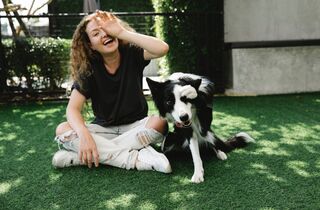Personality
Like Man, Like Dog: Owner-Dog Resemblance
Is it a psychological phenomenon or a Disney fairy tale?
Posted November 7, 2022 Reviewed by Jessica Schrader
Key points
- Dogs and their owners often resemble each other in appearance.
- The causes for this phenomenon are thought to lie in the choice of a similar-looking dog.
- Dog and owner may also share similar personality traits.
We have seen it in movies like the classic 101 Dalmatians or the modern Pets: dogs seem to look like their owners. Although the representations in common media are clearly overdrawn, perhaps you have also observed this phenomenon in everyday life: a thin lady with a greyhound or a bodybuilder with an equally muscular boxer. You may be surprised to learn that the question of whether dog and owner are indeed similar is actually the subject of several scientific studies.
Dogs and owners look alike
Research does indeed support the conclusion that similarity between dog and owner exists. Dogs, for example, often resemble their owners in terms of their ear length and owners’ hair length (Nakajima et al., 2009). It is really true: the longer the hair of the owners, the longer the floppy ears of their furry companions. If the dog or owner is obese, it is often observed in the other individual as well (Nijland et al., 2009). One way to test the similarity of dogs and owners is the photo test. Participants receive photos from dogs and from owners, and they then have to match them. And yes, they can indeed find the right dog-owner pairs (Payne & Jaffe, 2005; Roy & Christenfeld, 2004, 2005). In one study, they could match the photos even when only the eye region of the dogs and owners was shown in the photographs (Nakajima, 2015).

Dogs and owners behave alike
But dogs and owners do not only look similar, they may also resemble each other in the way they behave in certain situations, or as psychologists call it: in their personality traits. Personality traits in dogs? Yes. There is not only scientific evidence for human-like personality traits in dogs, but also well-established tools to measure it exists. Four of the human "big five" personality traits can also be identified in dogs (extraversion, neuroticism, agreeableness, and openness to experience). Only the trait of conscientiousness does not seem to exist in dogs (Gosling et al., 2003). The strongest similarities can be found in the dimensions of neuroticism (Cavanaugh et al., 2008) and extraversion (Dodman et al., 2018). What does that mean? The degree of emotional stability and therefore the way dog and owner react to their environment is often similar. Dogs and their owners are often either both shy or both outgoing. Thus, you can imagine that the above-mentioned bodybuilder with his boxer also make a similar impression if they are both outgoing.
Why are dogs and owners similar?
The short answer is that we do not know yet in detail. But what scientists do agree on is that the internal similarity tends to develop over time, while the external similarity arises from the decision when purchasing the animal. Why owner and dog become more similar over the time of ownership, can be explained by various theories. For example, it is likely that over time two individuals in a relationship become emotionally similar, this helps to coordinate their thoughts and behaviors to navigate the challenges of everyday life (Anderson et al., 2003). It is also possible that—like in an old couple—each partner repeatedly regulates the behavior of the other (Butler & Randall, 2013). Do you know the situation in which an old couple tries to tell a joke and interrupts each other again and again? Something similar can happen in a long-lasting dog-owner relationship: They regulate the behavior of each other, although I guess it might be better in everyday life when owners have more influence on their dog than vice versa.
But what about external similarity—why do dogs look like their owners? Maybe owners choose dogs who look like themselves, because their own appearance is seen as the familiar ideal (Zajonc, 1968). In other words, as I am familiar with my own appearance, I also purchase a dog who looks like me.
Thus, we still do not know exactly the reasons for the similarity between dogs and humans. But just that it exists highlights the truly special relationship between dogs and humans that has developed over the thousands of years of domestication.
This post was written in cooperation with Yana Bender, a Ph.D. student working on this topic.
References
Anderson, C., Keltner, D., & John, O. P. (2003). Emotional convergence between people over time. Journal of Personality and Social Psychology, 84(5), 1054–1068.
Butler, E. A., & Randall, A. K. (2013). Emotional Co-regulation in Close Relationships. Emotion Review, 5(2), 202–210.
Cavanaugh, L.A., Leonard, H., & Scammon, D. (2008). A Tail of Two Personalities: How Canine Companions Shape Relationships and Well-Being. Journal of Business Research, 61(5), 469 479.
Dodman, N. H., Brown, D. C., & Serpell, J. A. (2018). Associations between owner personality and psychological status and the prevalence of canine behavior problems. PLoS One, 13(2), 1-11.
Gosling, S. D., Kwan V. S., & John, O. P. (2003). A dog’s got personality: a cross-species comparative approach to personality judgements in dogs and humans. Journal of Personality and Social Psychology, 85(6), 1161-1169.
Nakajima, S. (2015). Dogs and Owners Resemble Each Other in the Eye Region. Anthrozoös, 26(4), 551-556.
Nakajima, S., Yamamoto, M., & Yoshimoto, N. (2009). Dogs look like their owners: Replications with racially homogeneous owner portraits. Anthrozoös, 22(2), 173–181.
Nijland, M. L., Stam, F., & Seidell, J. C. (2009). Overweight in dogs, but not in cats, is related to overweight in their owners. Public Health Nutrition, 13(1), 102–106.
Payne, C., & Jaffe, K. (2005). Self seeks like: Many humans choose their dog pets following rules used for assortative mating. Journal of Ethology, 23, 15–18.
Roy, M.M., & Christenfeld, N. J. S. (2004). Do dogs resemble their owners? Psychological Science, 15(5), 361–363.
Roy, M. M., & Christenfeld, N. J. S. (2005). Dogs still resemble their owners. Psychological Science, 16(9), 743–744.
Zajonc, R.B. (1968). Attitudinal effects of Mere exposure. Journal of Personality and Social Psychology Monographs, 9(2), 1-27.


